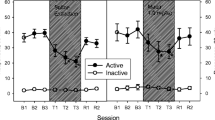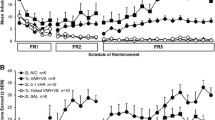Abstract
Rationale
The antidepressant nortriptyline is a second-line pharmacotherapy for smoking cessation. Given that there is limited preclinical data available on the effects of nortriptyline on responses to nicotine, the present study sought to evaluate its effects on the reinforcing, discriminative stimulus (DS) and aversive effects of nicotine in male hooded Lister rats.
Methods
The effects of nortriptyline (0, 1, 3 and 10 mg/kg, i.p.) on responding under the control of a second order schedule of nicotine (0.03 mg/kg per infusion) intravenous self-administration (IVSA; n = 7), food-maintained responding (n = 6), discrimination of nicotine (0.2 mg/kg, s.c.) from saline in a two-lever procedure controlled by a fixed ratio and variable interval schedule of food reinforcement (n = 12) and on the development of nicotine- and lithium-induced conditioned taste aversions (CTA) (n = 8 per dose of nortriptyline) were examined.
Results
Nortriptyline (3 mg/kg) reduced responding for nicotine in the drug-free interval in which behaviour was supported by nicotine-associated cues and subsequent intervals in which nicotine was available; however, food-maintained responding was also reduced at the same dose. Nortriptyline (3 mg/kg) blocked the development of a nicotine-induced CTA but not a lithium-induced CTA, indicating that these effects are unlikely to be due to non-specific effects of nortriptyline on taste perception or learning. Lastly, nortriptyline had no effect on the DS properties of nicotine.
Conclusions
Nortriptyline appears to attenuate the reinforcing and aversive stimulus properties of nicotine, which may mediate its anti-smoking effects. However, the results should be interpreted with caution, as non-specific effects of nortriptyline may have contributed to these findings.





Similar content being viewed by others
References
Ascher JA, Cole JO, Colin JN, Feighner JP, Ferris RM, Fibiger HC, Golden RN, Martin P, Potter WZ, Richelson E et al (1995) Bupropion: a review of its mechanism of antidepressant activity. J Clin Psychiatry 56:395–401
Coen KM, Adamson KL, Corrigall WA (2009) Medication-related pharmacological manipulations of nicotine self-administration in the rat maintained on fixed- and progressive-ratio schedules of reinforcement. Psychopharmacology 201:557–568
Corrigall WA, Coen KM (1989) Nicotine maintains robust self-administration in rats on a limited-access schedule. Psychopharmacology 99:473–478
Cryan JF, Gasparini F, van Heeke G, Markou A (2003) Non-nicotinic neuropharmacological strategies for nicotine dependence: beyond bupropion. Drug Discov Today 8:1025–1034
da Costa CL, Younes RN, Lourenco MTC (2002) Stopping smoking: a prospective, randomized, double-blind study comparing nortriptyline to placebo. Chest 122:403–408
Dekeyne A, Gobert A, Auclair A, Girardon S, Millan MJ (2002) Differential modulation of efficiency in a food-rewarded “differential reinforcement of low-rate” 72-s schedule in rats by norepinephrine and serotonin reuptake inhibitors. Psychopharmacology 162:156–167
Donny EC, Caggiula AR, Mielke MM, Jacobs KS, Rose C, Sved AF (1998) Acquisition of nicotine self-administration in rats: the effects of dose, feeding schedule, and drug contingency. Psychopharmacology 136:83–90
Everitt BJ, Robbins TW (2000) Second-order schedules of drug reinforcement in rats and monkeys: measurement of reinforcing efficacy and drug-seeking behaviour. Psychopharmacology 153:17–30
Fiore MC (2000) US public health service clinical practice guideline: treating tobacco use and dependence. Respir Care 45:1200–1262
Fryer JD, Lukas RJ (1999) Antidepressants noncompetitively inhibit nicotinic acetylcholine receptor function. J Neurochem 72:1117–1124
Garcia J, Ervin FR (1968) Appetites, aversions, and addictions: a model for visceral memory. Recent Adv Biol Psychiatry 10:284–293
Gasior M, Shoaib M, Yasar S, Jaszyna M, Goldberg SR (1999) Acquisition of nicotine discrimination and discriminative stimulus effects of nicotine in rats chronically exposed to caffeine. J Pharmacol Exp Ther 288:1053–1073
Goldberg SR, Gardner ML (1981) Second-order schedules: extended sequences of behavior controlled by brief environmental stimuli associated with drug self-administration. NIDA Res Monogr 37:241–270
Goldberg SR, Henningfield JE (1988) Reinforcing effects of nicotine in humans and experimental animals responding under intermittent schedules of i.v. drug injection. Pharmacol Biochem Behav 30:227–234
Gommans J, Stolerman IP, Shoaib M (2000) Antagonism of the discriminative and aversive stimulus properties of nicotine in C57BL/6J mice. Neuropharmacology 39:2840–2847
Hall SM, Reus VI, Munoz RF, Sees KL, Humfleet G, Hartz DT, Frederick S, Triffleman E (1998) Nortriptyline and cognitive-behavioral therapy in the treatment of cigarette smoking. Arch Gen Psychiatry 55:683–690
Hall SM, Humfleet GL, Reus VI, Munoz RF, Hartz DT, Maude-Griffin R (2002) Psychological intervention and antidepressant treatment in smoking cessation. Arch Gen Psychiatry 59:930–936
Hall SM, Humfleet GL, Reus VI, Munoz RF, Cullen J (2004) Extended nortriptyline and psychological treatment for cigarette smoking. Am J Psychiatry 161:2100–2107
Hughes JR, Stead LF, Lancaster T (2007) Antidepressants for smoking cessation. [update in Cochrane Database of Syst Rev. 2007; (1): CD000031; PMID:14651858]. Cochrane Database of Systematic Reviews
Jones JD, Hall FS, Uhl GR, Rice K, Riley AL (2009) Differential involvement of the norepinephrine, serotonin and dopamine reuptake transporter proteins in cocaine-induced taste aversion. Pharmacol Biochem Behav 93:75–81
Kumar R, Pratt JA, Stolerman IP (1983) Characteristics of conditioned taste aversion produced by nicotine in rats. Br J Pharmacol 79:245–253
Morrison CF, Stephenson JA (1969) Nicotine injections as the conditioned stimulus in discrimination learning. Psychopharmacologia 15:351–360
Overton DA, Hayes MW (1984) Optimal training parameters in the two-bar fixed-ratio drug discrimination task. Pharmacol Biochem Behav 21:19–28
Paterson NE, Semenova S, Markou A (2008) The effects of chronic versus acute desipramine on nicotine withdrawal and nicotine self-administration in the rat. Psychopharmacology 198:351–362
Perkins KA, DiMarco A, Grobe JE, Scierka A, Stiller RL (1994) Nicotine discrimination in male and female smokers. Psychopharmacology 116:407–413
Preston KL, Bigelow GE (1991) Subjective and discriminative effects of drugs. Behav Pharmacol 2:293–313
Prochazka AV, Weaver MJ, Keller RT, Fryer GE, Licari PA, Lofaso D (1998) A randomized trial of nortriptyline for smoking cessation. Arch Intern Med 158:2035–2039
Prochazka AV, Kick S, Steinbrunn C, Miyoshi T, Fryer GE (2004) A randomized trial of nortriptyline combined with transdermal nicotine for smoking cessation. Arch Intern Med 164:2229–2233
Rauhut A, Mullins S, Dwoskin LP, Bardo MT (2002) Reboxetine: attenuation of intravenous nicotine self-administration in rats. J Pharmacol Exp Ther 303:664–672
Rauhut AS, Neugebauer N, Dwoskin LP, Bardo MT (2003) Effect of bupropion on nicotine self-administration in rats. Psychopharmacology 169:1–9
Rauhut AS, Hawrylak M, Mardekian SK, Rauhut AS, Hawrylak M, Mardekian SK (2008) Bupropion differentially alters the aversive, locomotor and rewarding properties of nicotine in CD-1 mice. Pharmacol Biochem Behav 90:598–607
Richelson E, Pfenning M (1984) Blockade by antidepressants and related compounds of biogenic amine uptake into rat brain synaptosomes: most antidepressants selectively block norepinephrine uptake. Eur J Pharmacol 104:277–286
Sanchez C, Hyttel J (1999) Comparison of the effects of antidepressants and their metabolites on reuptake of biogenic amines and on receptor binding. Cell Mol Neurobiol 19:467–489
Schindler CW, Panlilio LV, Goldberg SR (2002) Second-order schedules of drug self-administration in animals. Psychopharmacology 163:327–344
Shoaib M, Stolerman IP (1995) Conditioned taste aversions in rats after intracerebral administration of nicotine. Behav Pharmacol 6:375–385
Shoaib M, Thorndike E, Schindler CW, Goldberg SR (1997) Discriminative stimulus effects of nicotine and chronic tolerance. Pharmacol Biochem Behav 56:167–173
Shoaib M, Zubaran C, Stolerman IP (2000) Antagonism of stimulus properties of nicotine by dihydro-beta-erythroidine (DHbetaE) in rats. Psychopharmacology 149:140–146
Shoaib M, Gommans J, Morley A, Stolerman IP, Grailhe R, Changeux JP (2002) The role of nicotinic receptor beta-2 subunits in nicotine discrimination and conditioned taste aversion. Neuropharmacology 42:530–539
Shoaib M, Sidhpura N, Shafait S (2003) Investigating the actions of bupropion on dependence-related effects of nicotine in rats. Psychopharmacology 165:405–412
Slemmer JE, Martin BR, Damaj MI (2000) Bupropion is a nicotinic antagonist. J Pharmacol Exp Ther 295:321–327
Warner C, Shoaib M (2005) How does bupropion work as a smoking cessation aid? Addict Biol 10:219–231
Whitelaw RB, Markou A, Robbins TW, Everitt BJ (1996) Excitotoxic lesions of the basolateral amygdala impair the acquisition of cocaine-seeking behaviour under a second-order schedule of reinforcement. Psychopharmacology 127:213–224
Wing VC, Shoaib M (2007) Examining the clinical efficacy of bupropion and nortriptyline as smoking cessation agents in a rodent model of nicotine withdrawal. Psychopharmacology 195:303–313
Wing VC, Shoaib M (2008) Contextual stimuli modulate the extinction and reinstatement in rodents self-administering intravenous nicotine. Psychopharmacology 200:357–365
Wing VC, Shoaib M (2010) Second-order schedules of nicotine reinforcement in rats: effect of AM251. Addict Biol 15:393–402
Wong EH, Sonders MS, Amara SG, Tinholt PM, Piercey MF, Hoffmann WP, Hyslop DK, Franklin S, Porsolt RD, Bonsignori A, Carfagna N, McArthur RA (2000) Reboxetine: a pharmacologically potent, selective, and specific norepinephrine reuptake inhibitor. Biol Psychiatry 47:818–829
Zhou J (2004) Norepinephrine transporter inhibitors and their therapeutic potential. Drugs Future 29:1235–1244
Acknowledgements
This research was supported by Newcastle University, UK. We thank Parisa Rahimpourojani for her assistance with the conditioned taste aversion and discrimination experiments, and Emma Malcolm for her assistance with the nicotine self-administration experiment.
Author information
Authors and Affiliations
Corresponding author
Rights and permissions
About this article
Cite this article
Wing, V.C., Shoaib, M. Translating the smoking cessation properties of the antidepressant nortriptyline using reinforcing, discriminative and aversive stimulus effects of nicotine in rats. Psychopharmacology 219, 847–857 (2012). https://doi.org/10.1007/s00213-011-2413-2
Received:
Accepted:
Published:
Issue Date:
DOI: https://doi.org/10.1007/s00213-011-2413-2




